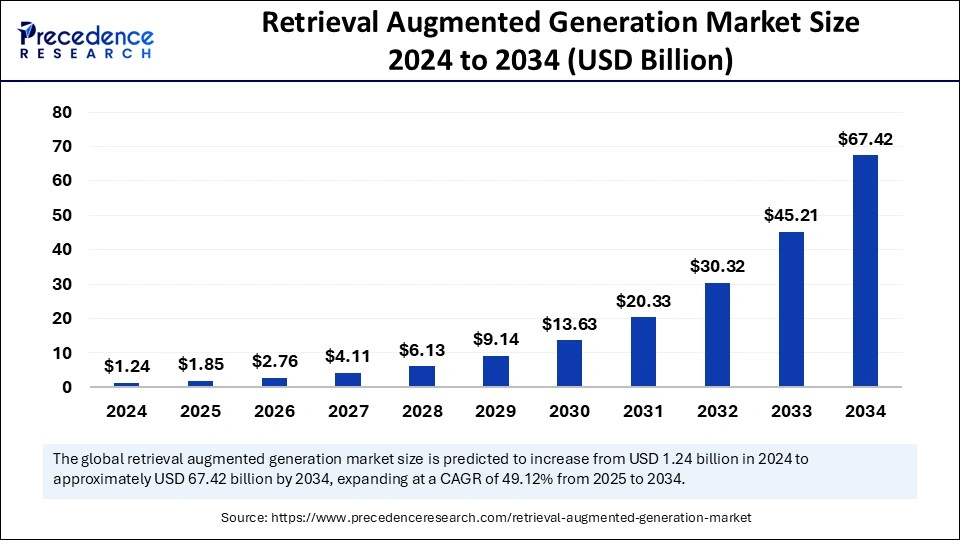
Retrieval Augmented Generation Market Key Takeaways
- North America dominated the global market with the largest share around 37% in 2024.
- Asia Pacific is expected to grow at the fastest CAGR during the forecast period.
- The European market is observed to grow at a considerable CAGR.
- By function, the document retrieval segment dominated the market in 2024.
- By function, the recommendation engine segment is expected to witness significant growth during the predicted timeframe.
- By application, in 2024, the content-generation segment captured the biggest market share in 2024.
- By application, the customer support and chatbots segment is expected to grow at the fastest CAGR over the forecast period.
- By end use, the retail and e-commerce segment contributed the highest market share in 2024.
- By end use, the healthcare segment is expected to grow at the fastest CAGR in the studied years.
- By deployment, the cloud segment held the largest market share in 2024.
- By deployment, the on-premises segment is expected to grow at the fastest CAGR in the coming years.
Market Overview
The retrieval augmented generation market is quickly transforming how AI-driven systems generate content by enabling real-time information sourcing from external knowledge bases. This approach bridges the gap between static language models and dynamic information environments, creating highly responsive, accurate, and contextually relevant outputs. With rising demands for transparency and data grounding in generative AI outputs, the retrieval augmented generation market is gaining importance in enterprise applications, digital assistants, and professional services automation.
Drivers
A major driver of the retrieval augmented generation market is the growing demand for trustworthy AI outputs that can be traced to verifiable sources. Organizations are increasingly adopting RAG-based tools to improve productivity while minimizing misinformation. The integration of RAG into chatbots, knowledge assistants, and decision support systems is being driven by enterprises’ desire to boost operational efficiency without compromising on accuracy. Additionally, the ability to customize RAG models for specific domains and industries adds to its attractiveness, making it a preferred option for organizations in highly regulated sectors.
Opportunities
There are extensive opportunities in the retrieval augmented generation market for vendors offering plug-and-play solutions that can be easily integrated with existing enterprise data repositories. Sectors such as healthcare, finance, and education are especially well-positioned to benefit from RAG technologies, as they require precise and up-to-date information delivery. There is also an emerging market for RAG applications in multilingual communication tools and accessibility solutions. Startups and independent developers have opportunities to build specialized RAG systems on open-source frameworks, further diversifying the applications of retrieval augmented generation.
Challenges
One of the key challenges facing the retrieval augmented generation market is the complexity of optimizing information retrieval components alongside generative models to ensure seamless user experiences. Ensuring relevance, precision, and fairness in search and generation processes remains a major technical hurdle. Additionally, the cost of training, deploying, and maintaining RAG models—especially with large knowledge bases—can be prohibitive for smaller organizations. Data security, bias mitigation, and regulatory compliance also represent ongoing challenges that must be addressed for widespread adoption of retrieval augmented generation systems.
Regional Insights
The retrieval augmented generation market is most mature in North America, where leading technology companies and research institutions are investing heavily in generative AI infrastructure. The European Union is supporting AI research through policy-driven funding, especially around explainable and ethical AI, making it a key region for RAG development. In the Asia-Pacific region, rapid digital transformation and growing AI startups are contributing to increased interest in retrieval augmented generation systems. Countries like Singapore, Japan, and Australia are emerging as hubs for experimentation with applied RAG technologies in both public and private sectors.
Recent Developments
Recent advancements in the retrieval augmented generation market include the launch of domain-specific RAG solutions designed for legal, academic, and clinical settings. Enterprises are also adopting vector databases and semantic search technologies to improve the quality and speed of RAG responses. There has been a rise in API-first RAG platforms that allow easy integration into enterprise software stacks. Moreover, academic research is increasingly focusing on the interpretability and safety of RAG models, driving innovation in output validation methods and user feedback mechanisms.
Retrieval Augmented Generation Market Companies
- Anthropic
- Amazon Web Services Inc.
- Clarifai
- Cohere
- Google DeepMind
- Hugging Face
- IBM Watson
- Informatica
- Meta AI (Facebook AI)
- Microsoft
- Neeva
- OpenAI
- Semantic Scholar (AI2)
Segments Covered in Report
By Function
- Document Retrieval
- Response Generation
- Summarization and Reporting
- Recommendation Engines
By Application
- Knowledge Management
- Customer Support and Chatbots
- Legal and Compliance
- Marketing and Sales
- Research and Development
- Content Generation
By End User
- Healthcare
- Financial Services
- Retail and E-commerce
- IT and Telecommunications
- Education
- Media and Entertainment
- Others
By Deployment
- Cloud
- On-premises
By Regional
- North America
- Europe
- Asia Pacific
- Latin America
- Middle East and Africa